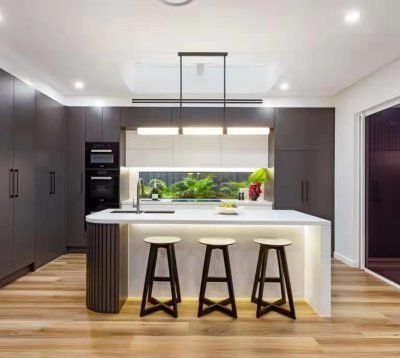Since it serves a fundamental purpose and is used so often, the kitchen usually takes center stage when thinking about remodeling or updating the house. Maybe one of the largest kitchen renovations is replacing the flooring. The durable and stylish appearance of hybrid flooring makes it an excellent option for kitchens. This post will go over the advantages of hybrid flooring over different kinds of flooring and the reasons it makes sense for kitchens.
Advantages of Hybrid Flooring from Two Worlds
The most beneficial aspects of laminate and vinyl are combined in one ground-breaking product. Its design is to withstand the harsh conditions—moisture, spills, and a lot of foot traffic—that often define kitchen settings. Because the core elements in hybrid flooring are water-resistant, it is a great option for moist areas. This function comes in quite handy in kitchens where spills happen often.
Features of hybrid kitchen flooring
- Durable and Maintainable:A major benefit of hybrid flooring is durability. It can take the abuses of a busy kitchen without warping or staining. Besides, hybrid flooring requires little upkeep—just routine sweeping and cleaning with mild detergents.
- Appeal to the Senses:The beauty of stone or wood is replicated in many of the patterns and designs of hybrid flooring. With the help of this collection, homeowners can choose a design that enhances the atmosphere of their kitchen and raises the overall visual attractiveness of the area.
- Cosiness and Thermal Insulation: Hybrid flooring not only looks great but also provides a necessary degree of underfoot comfort, especially in places where people stand for extended periods of time. Its more insulating than traditional tile or stone flooring keeps the kitchen warmer in the winter and cooler in the summer.
A Look at Hybrid Kitchen Flooring
Hybrid flooring for the kitchen should be chosen with consideration for color, pattern, and overall house design. Darker colors may offer a more personal atmosphere even if they can also give the impression of space in a smaller kitchen. Think also about the flooring’s finish, since some might provide more slip resistance—a characteristic that comes in handy in a kitchen.
Carpeting hybrid outside the restroom
It is noteworthy that, although kitchens are the main topic of this essay, Hybrid Flooring for Bathrooms is also a very good choice for bathrooms. Particularly beneficial in these areas are the moisture-resistant qualities of hybrid flooring. Whether remodeling a kitchen or bathroom, hybrid flooring offers an unmatched fusion of style and utility.
Installation and Longevity
Selecting click-lock flooring options might make hybrid flooring installation seem like a straightforward task. For best effects, however, think about having the flooring professionally installed to make sure it is well fitted and sealed. A well installed floor will last for many years both functionally and aesthetically.
A Comparison of Alternatives to Hybrid Flooring
Different from other kitchen flooring choices like hardwood or ceramic tile, hybrid flooring usually stands out for its own combination of features. More water-resistant than hardwood, it is softer and cozier underfoot than tile. For many home owners looking to add useful and beautiful flooring to their kitchen, these features make it a highly recommended choice.
Conclusion
Finally, hybrid flooring combines the beauty of natural materials with the useful benefits of water resistance and lifespan to provide a multipurpose and visually appealing flooring option for kitchens. Hybrid flooring for kitchens is a strong and beautiful choice that meets both functional and aesthetic needs whether choosing flooring for a new house or remodeling an old one.

